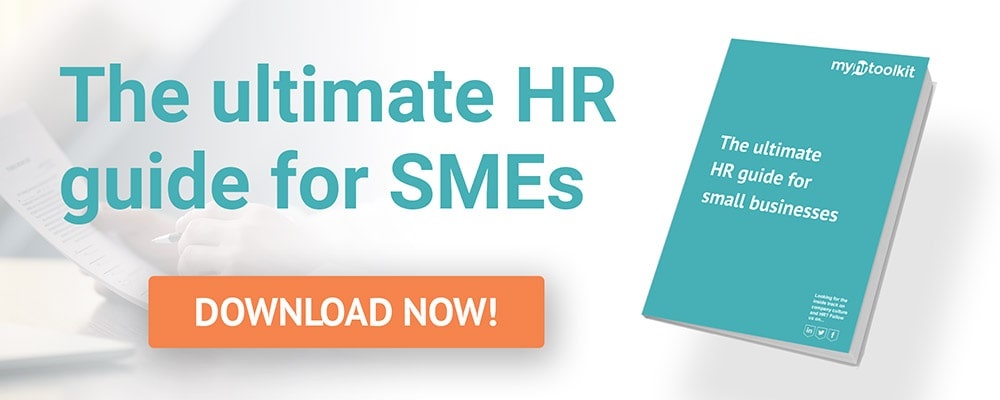What is HR and why does it matter that small businesses get it right? Here we provide an overview of what HR is and the different aspects SMEs should consider for better business productivity and profitability.
To start at the very beginning: HR is an abbreviation of Human Resources. According to Oxford’s Learner’s dictionaries, human resources means “people’s skills and abilities, seen as something a company, an organisation etc. can make use of.”
HR is then all about people, which is why it is also sometimes known as people management or personnel management. In a business context, HR is all about managing the use of people’s skills and abilities.
Included within this is everything from setting out company guidelines and policies (e.g. for how employees should use their skills and abilities whilst at work); to hiring and firing employees (deciding which skills and abilities the company needs and/or can make use of).
A brief history of HR

The term ‘HR’ was popularised in the 20th century. The effective management of people within businesses was taught in universities in business studies and business administration courses from the 1970s onwards, as businesses began to adapt to changing economic circumstances and technological growth.
With increasing competition from market forces and pressure from government legislation, HR became an essential arm of businesses, creating jobs for HR professionals whose job it was to implement and oversee key people management tasks such as hiring, firing, and ensuring that businesses stayed legally compliant.
Learn more: The history of HR management: traditional HR vs strategic HR
9 key HR concepts and what they mean
This by no means covers every aspect of HR for a small business, but this A-Z list of key HR concepts is a great place to start considering how HR impacts the business:
1. Absence management

In HR theory, absence management refers to the recording, tracking, and processing of employee absences. This includes addressing any underlying issues and introducing strategies to hopefully reduce sickness absence, organising return to work interviews, and using measurements such as the Bradford Factor to assess absence patterns and frequency.
More recently, organisations have become more aware of the related issues of presenteeism (working while sick) and leaveism (taking holiday instead of sick leave), which can be just as problematic for a business as absence from work.
2. Compliance
Compliance simply means ensuring that businesses stay operating under the confines of the law: it covers everything from keeping employee and customer data safe and secure (GDPR compliance), to ensuring health and safety regulations are met, to eliminating discrimination in the recruitment process. To learn more about the various areas of compliance businesses need to maintain, read our article on what SMEs need to know about maintaining business compliance.
3. Discipline and grievances

HR professionals are usually tasked with writing up and/or enforcing disciplinary procedures and grievance policies. In HR, discipline will include things like issuing employees with formal warnings for breaching a clause as set out in their employment contract or for misconduct. Grievances will usually involve dealing with complaints issued by employees regarding other employees or some aspect of their job.
4. Diversity and equality
It is the responsibility of HR to ensure that business policies do not directly or indirectly discriminate against any protected characteristics, such as gender, race, or sexuality. HR might also promote recruitment policies that encourage diversity within the workforce (e.g. a tech company aiming to hire women for certain roles in which there is a disproportionate skew towards men).
5. Employee engagement

As well as dealing with formalities such as absence management, legal compliance, and discipline and grievance policies, HR professionals are sometimes also tasked with implementing employee engagement strategies. This might involve things like making note of employee’s birthdays and other key milestones, or simply ensuring that employees are satisfied with their job by making time for them to provide regular feedback.
6. Learning and development
Having a robust learning and development strategy for employees is an important aspect of HR. From company-wide training courses to personal development opportunities, there are many ways to upskill employees for the betterment of the business and to keep employees motivated and engaged. It’s best to conduct a training needs analysis to identify skill gaps and plan how to address them, in order to improve productivity and profitability.
7. Pay and benefits

Managing and tracking staff wages and salaries is a basic aspect of HR that is crucial for businesses to get right. From discussing pay with employees to considering the impacts of financial wellbeing on your organisation, it can have a huge impact on employee engagement and retention. So too can the benefits you offer, with some benefits and perks being much more popular than others.
8. Performance management
Beyond learning and development goals, it’s important in general to manage employee performance across the business, to see who is performing well, identify areas for improvement, and help staff who are performing poorly.
Performance management has moved on from the days of the annual appraisal – nowadays, businesses are more focused on having regular catch-ups about performance in line with an agreed management framework. To learn more, read our guide on 3 performance management techniques to boost your small business.
9. Recruitment and onboarding

How you recruit and onboard employees is so important, as these initial stages can spell success or disaster when it comes to getting the right staff for your business. Developing a strong employer brand, perfecting your recruitment strategies, and experimenting with creative onboarding ideas can all help you create a dynamic recruitment and onboarding strategy that increases employee satisfaction, business productivity, and ultimately your bottom line.
HR and the law
HR is closely allied to employment law. Disciplinary and grievance processes often relate to violations of law (e.g. sexual harassment in the workplace), and recruitment and dismissal policies also have important legal ramifications. In recent years, with the introduction of GDPR, ensuring that businesses keep their data safe and secure has become a priority for HR professionals. For more sensitive or complex issues, HR professionals should seek qualified legal advice.
Learn more: Employment law changes 2021: what employers need to know
HR and technology

The advance of technology means that HR activities are likely to increasingly be mediated or replaced by technology, such as HR software systems, payroll software, and Applicant Tracking Systems (ATS).
Advances in technology mean that core HR processes such as recruitment and employee onboarding are being radically transformed. Businesses can use various HR systems to save time and money on areas like basic HR admin, organising interviews/meetings and sending reminders, and calculating things like holiday entitlement or wage/salary information for payroll.
One key area in which technology is transforming HR is in the area of data analytics. Business data such as rates of turnover and absence data are being used to inform businesses of areas where there might be problems. Data analytics can help businesses identify issues, plan ahead, and make data-led decisions when it comes to HR.
By adopting technological solutions and making the most of their people data, small businesses can concentrate on the more strategic aspects of HR and staff management, to improve productivity levels and achieve business goals.

Written by Camille Brouard
Camille is a Senior Marketing Executive for myhrtoolkit who writes on topics including HR technology, workplace culture, leave management, diversity, and mental health at work.


 Holiday Planner
Holiday Planner Absence Management
Absence Management Performance Management
Performance Management Staff Management
Staff Management Document Management
Document Management Reporting
Reporting Health and Safety Management
Health and Safety Management Task Management
Task Management Security Centre
Security Centre Self Service
Self Service Mobile
Mobile




